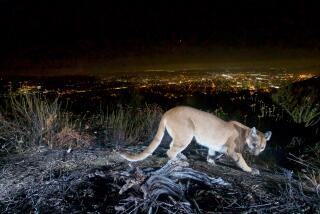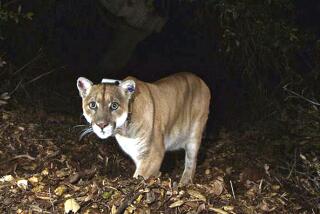Mountain Lions’ Odds on Having Cubs Improving
The recent discovery of four female mountain lions--one possibly pregnant--in north Orange County may mean the cats have a better chance of producing offspring in the rapidly developing region than researchers once believed.
The four adult females were captured in the past two weeks in the foothills of the Santa Ana Mountains north of Santiago Canyon Road.
In addition to the lion who may be pregnant, another appears to have mated recently, meaning at least one male lion has established a presence in the area, according to Paul Beier, a wildlife biologist who heads the Orange County Cooperative Mountain Lion Study. The two-year research project, funded by the county, was begun after lions mauled children in two separate attacks in 1986.
The four recently captured were tagged, fitted with radio collars and released so that their behavior can be studied.
‘Optimistic Picture’
“This is good news,” Beier said, referring to the possible matings. “This gives us a more optimistic picture of reproduction in the (mountain lion) population.”
Beier said as many as 35 lions may roam foothills and canyons in the Santa Ana Mountains. In 1988, researchers found and tagged four adult cats in Ronald W. Caspers Regional Park, a 7,500-acre recreation area, where the two 1986 maulings took place.
But the mating patterns of these lions, all females, caused some dismay among scientists. One of the females is traveling with two yearlings, but the other three have shown no reproductive activity for more than a year, Beier said.
The four captured recently were found in Blind and Fremont canyons, a rugged area of mountains, grassland and chaparral owned by the Irvine Co.
Although cattle ranchers use the area for grazing, no stock has been reported lost to the lions.
Beier said there are occasional sightings of the big cats on Santiago Canyon Road. An adult and a kitten were found dead on the road early this year. However, there have been no reports of attacks or encroachments in residential areas.
Researchers expanded their original study boundary from Caspers Park to north county in mid-May because the area encompasses land that is destined to become county wilderness parks.
“The county would like information about how the lions use these habitats so that when these areas become parks we can use the land in a way that minimizes the encounters between humans and animals,” Beier said.
Although researchers believe the Caspers Park lions travel over a large area of terrain that takes in parts of Orange, Riverside and San Diego counties, the range of the north county lions has yet to be determined, Beier said.
Researchers would also like to know where the cats hunt, what they eat, how they behave at the edge of developed areas--for example, do they venture into areas of heavy construction activity?--and the points at which they cross Santiago Canyon Road.
Beier said he is working on a proposal to extend the mountain lion study, scheduled to expire in February, for another three years.
“We really need another three to five years to answer the questions the county wants answered,” Beier said. “Right now, we think the lions are doing OK, but we would like to make sure.”
More to Read
Sign up for Essential California
The most important California stories and recommendations in your inbox every morning.
You may occasionally receive promotional content from the Los Angeles Times.









